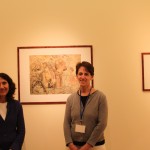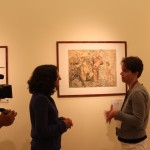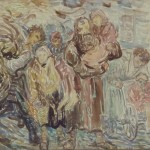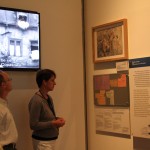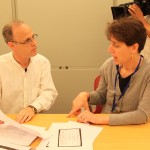Tel Aviv and Jerusalem really aren’t so far from one another – maybe an hour by car – but it made sense for the project to relocate because of our filming schedule. Besides, it’s definitely fun to be in different locations and experience different cities! We haven’t had a chance yet to see too much of the city of Jerusalem yet. We will do that today when we go out and film B-roll. B-roll footage are shots in films that show the location. Sometimes the main character is in the shot, sometimes it’s just the setting. These shots give what I would call, “texture,” to the film. They make the experience of watching the film richer by contextualizing the location of the more static interviews. I will post some of these pictures later today or earlier tomorrow – my time! Remember that Israel is 10 hours ahead of the West coast of California…
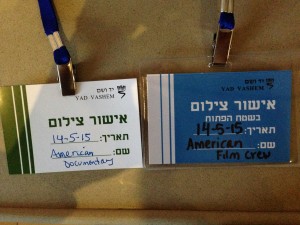 Yesterday we spent a significant amount of time at Yad Vashem (press passes with permission to film inside and outside at left). Yad Vashem is, of course, Israel’s official memorial to the victims of the Holocaust. My understanding is that after the Western Wall (or wailing wall) in old Jerusalem, it is the most visited site in Israel. Millions of visitors come to the museum and campus. It is a large place with an extensive art collection (they hold about 9,000 original paintings) as well as a history museum (the part most people visit) that tells the story of the rise of Nazism, the plight of Jews, death camps, and the survivors.
Yesterday we spent a significant amount of time at Yad Vashem (press passes with permission to film inside and outside at left). Yad Vashem is, of course, Israel’s official memorial to the victims of the Holocaust. My understanding is that after the Western Wall (or wailing wall) in old Jerusalem, it is the most visited site in Israel. Millions of visitors come to the museum and campus. It is a large place with an extensive art collection (they hold about 9,000 original paintings) as well as a history museum (the part most people visit) that tells the story of the rise of Nazism, the plight of Jews, death camps, and the survivors.
I came to visit Yad Vashem for a very particular and important reason that has very much to do with the Chasing Portraits project. Many years ago, I think it was the early 2000s, my family was contacted by Yad 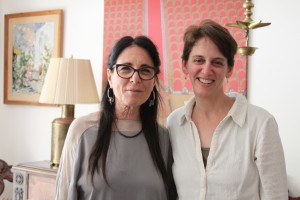 Vashem. Their head art curator, Yehudit Shendar (who is now retired from Yad Vashem and whom I interviewed a few days ago), wanted to come to our home to see the Moshe Rynecki art collection. When she came she looked at many of the paintings, but then zeroed in on a painting titled Refugees, painted 25 September 1939. Since Hitler invaded Poland on 1 September 1939, this was in the very early days of the war. The painting shows several figures who appear to be moving, relocating, and generally dealing with the reality of war in Warsaw. Yehudit wished for the painting to be donated to the museum’s art collection and for the image to be included in Yad Vashem’s history museum. A large part of my reason for coming to Jerusalem was to see the painting on display. I had not seen the piece since it left California.
Vashem. Their head art curator, Yehudit Shendar (who is now retired from Yad Vashem and whom I interviewed a few days ago), wanted to come to our home to see the Moshe Rynecki art collection. When she came she looked at many of the paintings, but then zeroed in on a painting titled Refugees, painted 25 September 1939. Since Hitler invaded Poland on 1 September 1939, this was in the very early days of the war. The painting shows several figures who appear to be moving, relocating, and generally dealing with the reality of war in Warsaw. Yehudit wished for the painting to be donated to the museum’s art collection and for the image to be included in Yad Vashem’s history museum. A large part of my reason for coming to Jerusalem was to see the painting on display. I had not seen the piece since it left California.
What’s interesting about the Yad Vashem history museum is that they have taken great efforts to include art in the exhibition. And while people do visit the art museum, most come for the history museum and this is, by far, the most crowded area of the complex. They’ve included art for a variety of reasons and I wish I could write about them as eloquently as Yehduit Shendar, Eliad Moreh-Rosenberg, and Niv Goldberg spoke about it. (It’s a good thing I have it all on film!). Basically the art is a way to convey the war years from those who were victims of the Nazi perpetrators. The art offers a unique insight and perspective that photographs and artifacts (concentration camp uniforms, shoes from Majdanek, stolen personal items) cannot. The art also inserts color into the story – remember, most of the photos from the Second World War are in black and white. But life, of course, was not in black and white. There are around 300 paintings included in the museum. I believe the exact number is 288 paintings.
I tell you all this so that you understand that my great-grandfather’s painting is actually in two places at Yad Vashem. It is part of the art collection where it rotates in and out of exhibition with the museum’s other holdings. Art work cannot be constant displayed. It must rest in a dark, temperature controlled room occasionally to preserve it. The image of my great-grandfather’s painting (a facsimile of the piece) is on permanent display in the history museum.
So here you see Eliad Moreh-Rosenberg, Senior Curator at Yad Vashem, standing with the original of my great-grandfather’s painting on display at Yad Vashem’s art gallery.
And here I am in the history museum looking at the exhibition display with Niv Goldberg, the Art Collection Manager at Yad Vashem. Niv and I also had a great discussion about my family’s history and records he was able to pull from its databases, including ITS (the International Training Service).
This Chasing Portraits filming trip is coming to an end. We have seen a lot and learned a great deal. I love to connect with others who have my great-grandfather’s work in their possession because we share a passion – an understanding of the importance of the story the art tells and the multi-layered parts of history that we all share.
I will post tomorrow about the footage we shoot today. And then this Chasing Portraits filming trip comes to an end. I have the weekend for time with family and playing tourist before returning to California. But there is more filming to come soon! In July the Chasing Portraits team reconvenes in New York to visit a Rynecki painting and sculpture…
Stay tuned!
